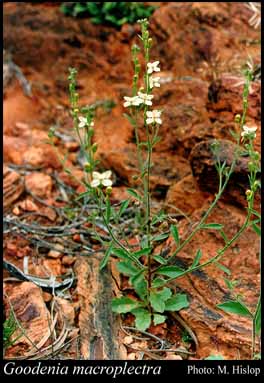- Reference
- Telopea 3: 551 (1990)
- Conservation Code
- Not threatened
- Naturalised Status
- Native to Western Australia
- Name Status
- Current
Erect annual, herb, 0.1-0.3 m high, corolla spurred. Fl. yellow/cream, Jul to Sep. Sandy soils, clay. Rocky places, quartzite hills, sandstone or laterite breakaways.

Scientific Description
Stems ribbed. Leaves flat, 10-35 mm long, 2-10 mm wide, Indumentum present, with dense, glandular hairs; margins entire or lobed. Bracteoles absent. Pedicel pedicellate, Pedicel length the pedicels 10-20 mm long, Indumentum present, Hair type with glandular hairs. Calyx lobes present, Calyx length 3-4 mm long, hairy, with sparse, glandular hairs. Corolla yellow, 9-12.5 mm long, without auricles, spurred, hairy on the outside, with sparse, glandular hairs, glabrous on the inside; central lobes 3.5-4.5 mm long, with wings; outer lobes 4-5.5 mm long, wings present on both sides, 0.6-1 mm wide. Anthers free. Ovary inferior, not gibbose; style 4.5-5.5 mm long, glabrous; indusium single, hairy; ovules more than two. Flowers in July, August and September. Occurs in the Yalgoo (YAL), Murchison (MUR), Great Victoria Desert (GVD), Carnarvon (CAR), Gascoyne (GAS) and Little Sandy Desert(LSD) IBRA Region(s), of the Eremaean (E) Botanical Province.
Distribution
- IBRA Regions
- Carnarvon, Gascoyne, Great Victoria Desert, Little Sandy Desert, Murchison, Yalgoo.
- IBRA Subregions
- Augustus, Carnegie, Eastern Murchison, Shield, Tallering, Trainor, Western Murchison, Wooramel.
- Local Government Areas (LGAs)
- Carnarvon, Cue, Laverton, Leonora, Meekatharra, Menzies, Mount Magnet, Murchison, Sandstone, Upper Gascoyne, Wiluna.